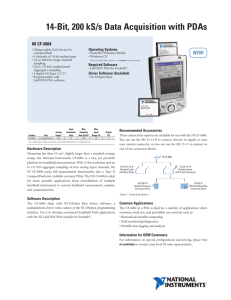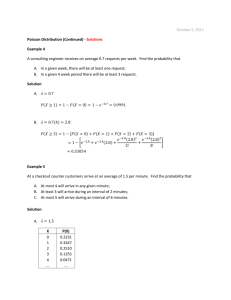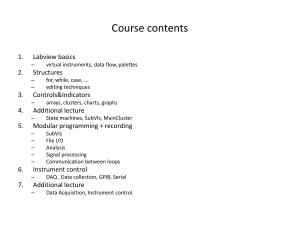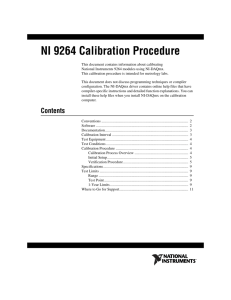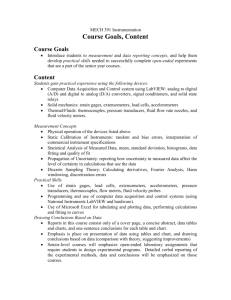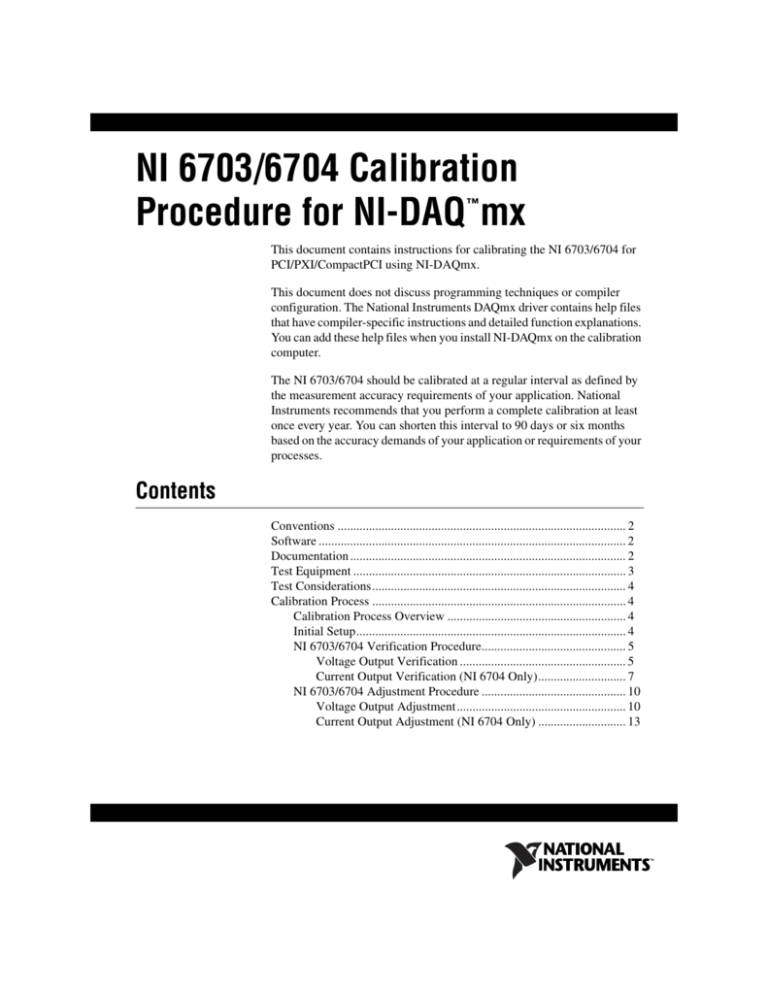
NI 6703/6704 Calibration
Procedure for NI-DAQ mx
™
This document contains instructions for calibrating the NI 6703/6704 for
PCI/PXI/CompactPCI using NI-DAQmx.
This document does not discuss programming techniques or compiler
configuration. The National Instruments DAQmx driver contains help files
that have compiler-specific instructions and detailed function explanations.
You can add these help files when you install NI-DAQmx on the calibration
computer.
The NI 6703/6704 should be calibrated at a regular interval as defined by
the measurement accuracy requirements of your application. National
Instruments recommends that you perform a complete calibration at least
once every year. You can shorten this interval to 90 days or six months
based on the accuracy demands of your application or requirements of your
processes.
Contents
Conventions ............................................................................................ 2
Software .................................................................................................. 2
Documentation ........................................................................................ 2
Test Equipment ....................................................................................... 3
Test Considerations................................................................................. 4
Calibration Process ................................................................................. 4
Calibration Process Overview ......................................................... 4
Initial Setup...................................................................................... 4
NI 6703/6704 Verification Procedure.............................................. 5
Voltage Output Verification ..................................................... 5
Current Output Verification (NI 6704 Only)............................ 7
NI 6703/6704 Adjustment Procedure .............................................. 10
Voltage Output Adjustment...................................................... 10
Current Output Adjustment (NI 6704 Only) ............................ 13
NI 6703/6704 Test Limits........................................................................17
Using the Tables ...............................................................................17
Test Point...................................................................................17
24-Hour Limits..........................................................................17
1-Year Limits ............................................................................18
Conventions
The following conventions appear in this manual:
This icon denotes a note, which alerts you to important information.
bold
Bold text denotes items that you must select or click in the software, such
as menu items and dialog box options. Bold text also denotes parameter
names and hardware labels.
italic
Italic text denotes variables, emphasis, a cross-reference, or an introduction
to a key concept. Italic text also denotes text that is a placeholder for a word
or value that you must supply.
monospace
Monospace text denotes text or characters that you should enter from the
keyboard, sections of code, programming examples, and syntax examples.
This font is also used for the proper names of disk drives, paths, directories,
programs, subprograms, subroutines, device names, functions, operations,
variables, filenames, and extensions.
monospace italic
Italic text in this font denotes text that is a placeholder for a word or value
that you must supply.
Software
Calibration requires the latest NI-DAQmx driver. NI-DAQmx includes
high-level function calls to simplify the task of writing software to calibrate
devices. The driver supports many programming languages, including
LabVIEW, LabWindows™/CVI™, Microsoft Visual C++, Microsoft Visual
Basic, and Borland C++.
Documentation
If you are using the NI-DAQmx driver, the following documents are your
primary references for writing your calibration utility:
•
The NI-DAQmx C Reference Help includes information about the
functions in the driver.
•
The DAQ Getting Started Guide for NI-DAQ 7.4 or later provides
instructions for installing and configuring NI-DAQ devices.
NI 6703/6704 Calibration Procedure for NI-DAQmx
2
ni.com
•
The NI-DAQmx Help includes information about creating applications
that use the NI-DAQmx driver.
For more information about the device you are calibrating, refer to the
NI 6703/6704 User Manual.
Test Equipment
Figure 1 shows the test equipment you need to calibrate your device. The
specific DMM connections are described in the Calibration Process
section.
Accessory
DMM
NI 6703/6704
Shielded Cable
AO GND
AO x
LO
HI
Figure 1. Calibration Connections
When performing calibration, National Instruments recommends that you
use the following instruments for calibrating an AO device:
•
DMM—NI 4070. If that instrument is unavailable, use a multi-ranging
5 1/2-digit DMM with an accuracy of 40 ppm (0.004%).
•
Low thermal copper EMF plug-in cables—Fluke 5440A-7002. Do not
use standard banana cables.
•
DAQ cable—NI recommends using shielded cables, such as the
SH68-68-EP.
•
One of the following DAQ accessories:
© National Instruments Corporation
–
SCB-68—The SCB-68 is a shielded I/O connector block with
68 screw terminals for easy signal connection to 68- or 100-pin
DAQ devices.
–
CB-68LP/CB-68LPR/TBX-68—The CB-68LP, CB-68LPR, and
TBX-68 are low-cost termination accessories with 68 screw
terminals for easy connection of field I/O signals to 68-pin DAQ
devices.
3
NI 6703/6704 Calibration Procedure for NI-DAQmx
Test Considerations
Follow these guidelines to optimize connections and test conditions during
calibration:
•
Keep connections to the NI 6703/6704 short. Long cables and wires act
as antennae, picking up extra noise, which can affect measurements.
•
Use shielded copper wire for all cable connections to the device.
•
Use twisted-pair wire to eliminate noise and thermal offsets.
•
Maintain a temperature between 18 and 28 °C. To operate the module
at a specific temperature outside this range, calibrate the device at that
temperature.
•
Keep relative humidity below 80%.
•
Allow a warm-up time of at least 15 minutes to ensure that the
measurement circuitry is at a stable operating temperature.
Calibration Process
This section provides instructions for verifying and calibrating your device.
Calibration Process Overview
The calibration process has four steps:
1.
Initial Setup—Configure your device in NI-DAQmx.
2.
NI 6703/6704 Verification Procedure—Verify the existing operation
of the device. This step allows you to confirm that the device was
operating within its specified range prior to calibration.
3.
NI 6703/6704 Adjustment Procedure—Perform an external calibration
that adjusts the device calibration constants with respect to a known
voltage source.
4.
Perform another verification to ensure that the device is operating
within its specifications after adjustment.
These steps are described in detail in the following sections. Because a
complete verification of all of the device’s ranges can take some time, you
may wish to verify only the ranges of interest to you.
Initial Setup
NI-DAQmx automatically detects the NI 6703/6704. However, for the
driver to communicate with the device, it must be configured in
NI-DAQmx.
NI 6703/6704 Calibration Procedure for NI-DAQmx
4
ni.com
To configure a device in NI-DAQmx, complete the following steps:
1.
Install the NI-DAQmx driver software.
2.
Power off the computer that will hold the device and install the device
in an available slot.
3.
Power on the computer and launch Measurement & Automation
Explorer (MAX).
4.
Configure the device identifier and select Self-Test to ensure that the
device is working properly.
When a device is configured with MAX, it is assigned a device identifier. Each
function call uses this identifier to determine which DAQ device to calibrate.
Note
NI 6703/6704 Verification Procedure
Verification determines how well the DAQ device is meeting its
specifications. By performing this procedure, you can see how your device
has changed over time. You can use this information to help determine the
appropriate calibration interval for your application.
The verification procedure is divided into the major functions of the device.
Throughout the verification process, use the tables in the NI 6703/6704 Test
Limits section to determine if your device needs to be adjusted.
Voltage Output Verification
This procedure verifies whether the output of voltage channel 0 is within
specifications. Because of the channel-to-channel matching of the
NI 6703/6704 voltage channels, if voltage channel 0 is operating within
specifications, all the voltage channels should be operating within
specifications.
If you want to verify the channels individually, you can expand this
procedure to verify all the voltage channels. Perform the procedure once
for each value of the channel parameter from 0 to 15. Each time you repeat
the procedure, connect the appropriate channel to the DMM.
To verify the voltage output, complete the following steps:
1.
Connect the DMM to the NI 6703/6704 as shown in the following
table.
Signal Name
Description
NI 6703/6704 Output
DMM Input
AO 0 (V)
AO 0 (V)
Pin 34
High
AO GND 0
Analog Ground 0
Pin 68
Low
© National Instruments Corporation
5
NI 6703/6704 Calibration Procedure for NI-DAQmx
2.
Place the DMM in voltage mode.
3.
Create a task using DAQmxCreateTask.
NI-DAQ Function Call
LabVIEW Block Diagram
Call DAQmxCreateTask with
the following parameters:
taskName: MyAOVoltageTask
taskHandle: &taskHandle
4.
LabVIEW does not require this step.
Add an AO voltage task using DAQmxCreateAOVoltageChan
(DAQmx Create Virtual Channel VI) and configure the channel,
AO 0 (V). Use the tables in the NI 6703/6704 Test Limits section to
determine the minimum and maximum values for your device.
NI-DAQ Function Call
LabVIEW Block Diagram
Call
DAQmxCreateAOVoltageChan
with the following parameters:
taskHandle: taskHandle
physicalChannel: dev1/ao0
nameToAssignToChannel:
AOVoltageChannel
minVal: –10.0
maxVal: 10.0
units: DAQmx_Val_Volts
customScaleName: NULL
5.
Start the generation using DAQmxStartTask
(DAQmx Start Task VI).
NI-DAQ Function Call
LabVIEW Block Diagram
Call DAQmxStartTask with
the following parameters:
taskHandle: taskHandle
NI 6703/6704 Calibration Procedure for NI-DAQmx
6
ni.com
6.
Generate 9.9 V on AO 0 (V) using DAQmxWriteAnalogF64
(DAQmx Write VI).
NI-DAQ Function Call
LabVIEW Block Diagram
Call DAQmxWriteAnalogF64
with the following parameters:
taskHandle: taskHandle
numSampsPerChan: 1
autoStart: 1
timeout: 10.0
dataLayout:
DAQmx_Val_GroupByChannel
writeArray: &voltage
sampsPerChanWritten:
&samplesWritten
reserved: NULL
7.
Compare the resulting value shown by the DMM to the upper and
lower limits listed in Table 1 in the NI 6703/6704 Test Limits section.
If the value is between these limits, the device passes the test.
8.
Clear the generation using DAQmxClearTask
(DAQmx Clear Task VI).
NI-DAQ Function Call
LabVIEW Block Diagram
Call DAQmxClearTask with the
following parameter:
taskHandle: taskHandle
9.
Repeat steps 3 through 8 generating 0 V.
10. Repeat steps 3 through 8 generating –9.9 V.
11. Disconnect the DMM from the NI 6703/6704.
You have now verified the voltage output of the NI 6703/6704.
Current Output Verification (NI 6704 Only)
This procedure verifies that the current output of channel 16 is within
specifications. Because of the channel-to-channel matching of the NI 6704
current channels, if current channel 16 is operating within specifications,
all the current channels should be operating within specifications.
© National Instruments Corporation
7
NI 6703/6704 Calibration Procedure for NI-DAQmx
You can also verify the channels individually for each current channel.
Perform the procedure once for each value of the channel parameter from
16 to 31. Each time you repeat the procedure, connect the appropriate
channel to the DMM.
To verify current output, complete the following steps:
1.
Connect the DMM to the NI 6704 as shown in the following table.
Signal Name
Description
NI 6704 Output
DMM Input
AO 16 (I)
AO 16 (I)
Pin 67
High
AO GND 16
Analog Ground 16
Pin 68
Low
2.
Place the DMM in current mode.
3.
Create a task using DAQmxCreateTask.
NI-DAQ Function Call
LabVIEW Block Diagram
Call DAQmxCreateTask with
the following parameters:
taskName: MyAOVoltageTask
taskHandle: &taskHandle
4.
LabVIEW does not require this step.
Add an AO voltage task using DAQmxCreateAOCurrentChan
(DAQmx Create Virtual Channel VI) and configure the channel,
AO 16 (I). Use the tables in the NI 6703/6704 Test Limits section to
determine the minimum and maximum values for your device.
NI-DAQ Function Call
LabVIEW Block Diagram
Call
DAQmxCreateAOCurrentChan
with the following parameters:
taskHandle: taskHandle
physicalChannel: dev1/ao16
nameToAssignToChannel:
AOCurrentChannel
minVal: 0
maxVal: 0.02
units: DAQmx_Val_Amps
customScaleName: NULL
NI 6703/6704 Calibration Procedure for NI-DAQmx
8
ni.com
5.
Start the generation using DAQmxStartTask
(DAQmx Start Task VI).
NI-DAQ Function Call
LabVIEW Block Diagram
Call DAQmxStartTask with
the following parameters:
taskHandle: taskHandle
6.
Generate 0.1 mA on AO 16 (I) using DAQmxWriteAnalogF64
(DAQmx Write VI).
NI-DAQ Function Call
LabVIEW Block Diagram
Call DAQmxWriteAnalogF64
with the following parameters:
taskHandle: taskHandle
numSampsPerChan: 1
autoStart: 1
timeout: 10.0
dataLayout:
DAQmx_Val_GroupByChannel
writeArray: &current
sampsPerChanWritten:
&samplesWritten
reserved: NULL
7.
Compare the resulting value shown by the DMM to the upper and
lower limits listed in Table 2 in the NI 6703/6704 Test Limits section.
If the value is between these limits, the device passes the test.
8.
Clear the generation using DAQmxClearTask
(DAQmx Clear Task VI).
NI-DAQ Function Call
LabVIEW Block Diagram
Call DAQmxClearTask with the
following parameter:
taskHandle: taskHandle
© National Instruments Corporation
9
NI 6703/6704 Calibration Procedure for NI-DAQmx
9.
Repeat steps 3 through 8 generating 20 mA.
10. Disconnect the DMM from the NI 6704.
You have now verified the current output of the NI 6704.
NI 6703/6704 Adjustment Procedure
At the end of each calibration procedure, new constants are stored in
the user calibration area of the NI 6703/6704, ensuring that the device
stores a permanent record of the calibration constants. Storing the
calibration constants here also ensures that the constants automatically load
when the NI 6703/6704 is powered on.
Voltage Output Adjustment
For the voltage outputs, you need to make offset and gain adjustments.
Adjust offsets first, followed by gains. Adjust offset and gain again to
ensure accuracy. This second set of offset and gain adjustments is
necessary because a large initial change in one of the calibration channels
can affect the accuracy of the other calibration channel.
The following table lists the offset and gain internal channels.
Calibration Channel
Internal Channel
Voltage Offset
_cal_ao_voltage_offset
Voltage Gain
_cal_ao_voltage_gain
To measure the voltage outputs, complete the following steps:
1.
Open a calibration session on your device using DAQmxInitExtCal
(DAQmx Initialize External Calibration VI). The default password
is NI.
NI-DAQ Function Call
LabVIEW Block Diagram
Call DAQmxInitExtCal
with the following
parameters:
deviceName: dev1
password: NI
calHandle: &calHandle
infoType:
ND_CALIBRATION_ENABLE
infoValue: ND_YES
NI 6703/6704 Calibration Procedure for NI-DAQmx
10
ni.com
2.
Connect the DMM to the NI 6703/6704 as shown in the following
table.
Signal Name
Description
NI 6703/6704 Output
DMM Input
AO 0 (V)
AO 0 (V)
Pin 34
High
AO GND 0
Analog Ground 0
Pin 68
Low
3.
Place the DMM in voltage mode.
4.
Create a task using DAQmxCreateTask.
NI-DAQ Function Call
LabVIEW Block Diagram
Call DAQmxCreateTask with
the following parameters:
taskName: MyAOVoltageTask
taskHandle: &taskHandle
5.
LabVIEW does not require this step.
Add an AO voltage task using DAQmxCreateAOVoltageChan
(DAQmx Create Virtual Channel VI) and configure the channel,
AO 0 (V).
NI-DAQ Function Call
LabVIEW Block Diagram
Call
DAQmxCreateAOVoltageChan
with the following parameters:
taskHandle: taskHandle
physicalChannel: dev1/ao0
nameToAssignToChannel:
AOVoltageChannel
minVal: –10.24
maxVal: 10.24
units: DAQmx_Val_Volts
customScaleName: NULL
© National Instruments Corporation
11
NI 6703/6704 Calibration Procedure for NI-DAQmx
6.
Start the generation using DAQmxStartTask
(DAQmx Start Task VI).
NI-DAQ Function Call
LabVIEW Block Diagram
Call DAQmxStartTask with
the following parameters:
taskHandle: taskHandle
7.
Generate 0.0 V on AO 0 (V) using DAQmxWriteAnalogF64
(DAQmx Write VI).
NI-DAQ Function Call
LabVIEW Block Diagram
Call DAQmxWriteAnalogF64
with the following parameters:
taskHandle: taskHandle
numSampsPerChan: 1
autoStart: 1
timeout: 10.0
dataLayout:
DAQmx_Val_GroupByChannel
writeArray: &voltage
sampsPerChanWritten:
&samplesWritten
reserved: NULL
8.
Repeat steps 4 through 7 replacing AO 0 (V) with
_cal_ao_voltage_offset. Continue to repeat step 7 with various
values in _cal_ao_voltage_offset until you have generated
approximately 0 V on AO 0 (V).
9.
Clear the generation using DAQmxClearTask
(DAQmx Clear Task VI).
NI-DAQ Function Call
LabVIEW Block Diagram
Call DAQmxClearTask with the
following parameter:
taskHandle: taskHandle
NI 6703/6704 Calibration Procedure for NI-DAQmx
12
ni.com
10. Repeat steps 4 through 9 generating 9.9 V on AO 0 (V), and replace
_cal_ao_voltage_offset with _cal_ao_voltage_gain.
Continue to repeat step 7 with various values in
_cal_ao_voltage_gain until you have generated approximately
9.9 V on AO 0 (V).
11. Repeat steps 4 through 10 to perform another set of offset and gain
adjustments until they are within the values listed in the 24-Hour
Limits column of Table 1 in the NI 6703/6704 Test Limits section.
12. Save the adjustment to the EEPROM, or onboard memory, using
DAQmxCloseExtCal (DAQmx Close External Calibration VI).
This function also saves the date, time, and temperature of the
adjustment to the onboard memory.
NI-DAQ Function Call
LabVIEW Block Diagram
Call DAQmxCloseExtCal
with the following
parameters:
calHandle: calHandle
action: DAQmx_Val_
Action_Commit
13. Disconnect the DMM from the device.
You have now adjusted the voltage output.
Current Output Adjustment (NI 6704 Only)
For the current outputs, you need to adjust offset and gain. Adjust offset
first, followed by gain. Adjust both offset and gain again to ensure
accuracy. This second set of offset and gain adjustments is necessary
because a large initial change in one of the calibration channels can affect
the accuracy of the other calibration channel.
The following table lists the offset and gain internal channels.
© National Instruments Corporation
Calibration Channel
NI 6704 Internal Channel
Current Offset
_cal_ao_current_offset
Current Gain
_cal_ao_current_gain
13
NI 6703/6704 Calibration Procedure for NI-DAQmx
To adjust the current outputs, complete the following steps:
1.
Open a calibration session on your device using DAQmxInitExtCal
(DAQmx Initialize External Calibration VI). The default password
is NI.
NI-DAQ Function Call
LabVIEW Block Diagram
Call DAQmxInitExtCal
with the following
parameters:
deviceName: dev1
password: NI
calHandle: &calHandle
infoType:
ND_CALIBRATION_ENABLE
infoValue: ND_YES
2.
Connect the DMM to the NI 6704 as shown in the following table.
Signal Name
Description
NI 6704 Output
DMM Input
AO 16 (I)
AO 16 (I)
Pin 67
High
AO GND 16
Analog Ground 16
Pin 68
Low
3.
Place the DMM in current mode.
4.
Create a task using DAQmxCreateTask.
NI-DAQ Function Call
Call DAQmxCreateTask with
the following parameters:
taskName: MyAOVoltageTask
taskHandle: &taskHandle
NI 6703/6704 Calibration Procedure for NI-DAQmx
LabVIEW Block Diagram
LabVIEW does not require this step.
14
ni.com
5.
Add an AO voltage task using DAQmxCreateAOCurrentChan
(DAQmx Create Virtual Channel VI) and configure the channel,
AO 16.
NI-DAQ Function Call
LabVIEW Block Diagram
Call
DAQmxCreateAOCurrentChan
with the following parameters:
taskHandle: taskHandle
physicalChannel: dev1/ao16
nameToAssignToChannel:
AOCurrentChannel
minVal: 0
maxVal: 0.0204
units: DAQmx_Val_Amps
customScaleName: NULL
6.
Start the generation using DAQmxStartTask
(DAQmx Start Task VI).
NI-DAQ Function Call
LabVIEW Block Diagram
Call DAQmxStartTask with
the following parameters:
taskHandle: taskHandle
© National Instruments Corporation
15
NI 6703/6704 Calibration Procedure for NI-DAQmx
7.
Generate 0.1 mA on AO 16 (I) using DAQmxWriteAnalogF64
(DAQmx Write VI).
NI-DAQ Function Call
LabVIEW Block Diagram
Call DAQmxWriteAnalogF64
with the following parameters:
taskHandle: taskHandle
numSampsPerChan: 1
autoStart: 1
timeout: 10.0
dataLayout:
DAQmx_Val_GroupByChannel
writeArray: &current
sampsPerChanWritten:
&samplesWritten
reserved: NULL
8.
Repeat steps 4 through 7 replacing AO 16 (I) with
_cal_ao_current_offset. Continue to repeat step 7 with various
values in _cal_ao_current_offset until you have generated
approximately 0.1 mA on AO 16 (I).
9.
Clear the generation using DAQmxClearTask
(DAQmx Clear Task VI).
NI-DAQ Function Call
LabVIEW Block Diagram
Call DAQmxClearTask with the
following parameter:
taskHandle: taskHandle
10. Repeat steps 4 through 9 generating 20.0 mA on AO 16 (I), and replace
_cal_ao_current_offset with _cal_ao_current_gain.
Continue to repeat step 7 with various values in
_cal_ao_current_gain until you have generated approximately
20.0 mA on AO 16 (I).
11. Repeat steps 4 through 10 to perform another set of offset and gain
adjustments until they are within the values listed in the 24-Hour
Limits column of Table 2 in the NI 6703/6704 Test Limits section.
NI 6703/6704 Calibration Procedure for NI-DAQmx
16
ni.com
12. Save the adjustment to the EEPROM, or onboard memory, using
DAQmxCloseExtCal (DAQmx Close External Calibration VI).
This function also saves the date, time, and temperature of the
adjustment to the onboard memory.
NI-DAQ Function Call
LabVIEW Block Diagram
Call DAQmxCloseExtCal
with the following
parameters:
calHandle: calHandle
action: DAQmx_Val_
Action_Commit
13. Disconnect the DMM from the device.
You have now adjusted the current output.
NI 6703/6704 Test Limits
The tables in this section list the accuracy specifications to use when
verifying and adjusting the NI 6703/6704. The tables display the
specifications for both 1-year and 24-hour calibration intervals. The 1-year
ranges display the specifications that the devices should meet if it has been
one year between calibrations. When a device has been calibrated with an
external source, the values shown in the 24-hour tables are the valid
specifications.
Using the Tables
The following definitions describe how to use the information from the
tables in this section.
Test Point
The Test Point is the voltage or current value that is generated for
verification purposes. Value refers to the voltage or current value to be
verified and is in volts or milliamps.
24-Hour Limits
The 24-Hour Limits column contains the Upper Limit and Lower Limit for
the test point value. That is, when the device is within its 24-hour
calibration interval, the test point value should fall between the upper and
lower limit values. Upper and lower limits are expressed in volts.
© National Instruments Corporation
17
NI 6703/6704 Calibration Procedure for NI-DAQmx
1-Year Limits
The 1-Year Limits column contains the Upper Limit and Lower Limit for
the test point value. That is, when the device is within its 1-year calibration
interval, the test point value should fall between the upper and lower limit
values. Upper and lower limits are expressed in volts.
Table 1. NI 6703/6704 Voltage Output Specifications
24-Hour Limits
1-Year Limits
Test Point
Value (V)
Lower Limit (V)
Upper Limit (V)
Lower Limit (V)
Upper Limit (V)
9.9
9.8991019
9.9008981
9.8989435
9.9010565
0.0
–0.0007100
0.0007100
–0.0007100
0.0007100
–9.9
–9.9008981
–9.8991019
–9.9010565
–9.8989435
Table 2. Current Output Specifications (NI 6704 Only)
24-Hour Limits
1-Year Limits
Test Point
Value (mA)
Lower Limit
(mA)
Upper Limit
(mA)
Lower Limit
(mA)
Upper Limit
(mA)
0.1
0.0985616
0.1014384
0.09855
0.10145
20
19.997885
20.002115
19.995565
20.004435
National Instruments, NI, ni.com, and LabVIEW are trademarks of National Instruments Corporation.
Refer to the Terms of Use section on ni.com/legal for more information about National
Instruments trademarks. Other product and company names mentioned herein are trademarks or trade
names of their respective companies. For patents covering National Instruments products, refer to the
appropriate location: Help»Patents in your software, the patents.txt file on your CD, or
ni.com/patents.
© 2005–2006 National Instruments Corporation. All rights reserved.
374081B-01
Apr06


